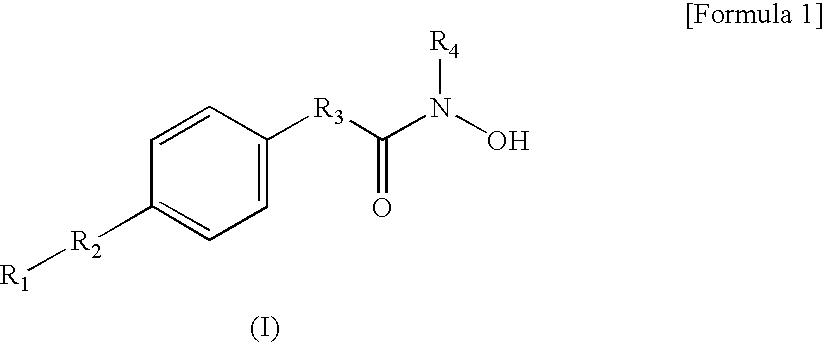Hydroxamic acid derivatives and the method for preparing thereof
a technology of hydroxamic acid and derivatives, which is applied in the field of hydroxamic acid derivatives, can solve the problems of skin irritation, lots of limitation in use, rough epidermis and loss of elasticity
- Summary
- Abstract
- Description
- Claims
- Application Information
AI Technical Summary
Benefits of technology
Problems solved by technology
Method used
Image
Examples
example 1
Preparation of N-[4-(N-hydroxycarbamoyl)phenyl]benzamide
[0111]20.0 g (0.16 mol) of benzoic acid was dissolved in 250 ml of pyridine and then was cooled in a ice bath of 10° C. Thereto, 23.1 g (0.21 mol) of ethyl chloroformate was added dropwise for 30 minutes. The mixture was stirred at room temperature for 2 hours and then filtered to remove salts, to give an anhydride (30.2 g, 0.15 mol). 24.1 G (0.16 mol) of metyl aminobenzoate was dissolved in 250 ml of pyridine and then was cooled in a ice bath of 10° C. Thereto, the anhydride formed in the previous step was added dropwise for 30 minutes. The mixture was stirred for another 2 hours. After distillation of the solvent, the residue was dissolved in 300 ml of ethyl acetate. The ethyl acetate solution was washed with 5% hydrochloric acid and with distilled water, dried over magnesium sulfate, decolorized with active charcoal, and then filtered. The filtrate was dried under reduced pressure, to give methyl 4-(phenylcarbonylamino) benz...
example 2
Preparation of N-[4-(N-hydroxycarbamoyl)phenyl][4-methylphenyl]carboxyamide
[0117]Except that 4-methylbenzoic acid was used instead of benzoic acid, the same procedure described in Example 1 was performed to give the title compound (11.9 g, 44% yield) as a pale yellow solid.
[0118]TLC (in ethyl acetate:hexane=1:1); Rf=0.51
[0119]1H-NMR(DMSO-d6): δ11.20(s, 1H), 10.41(s, 1H), 9.07(s, 1H), 7.94(m, 4H), 7.80(d, 2H, J=7.8Hz), 7.49(d, 2H, J=7.8 Hz), 2.33(s, 3H).
example 3
Preparation of N-[4-(N-hydroxycarbamoyl)phenyl][3-methylphenyl]carboxyamide
[0120]Except that 3-methylbenzoic acid was used instead of benzoic acid, the same procedure described in Example 1 was performed to give the title compound (11.2 g, 43% yield) as a pale yellow solid.
[0121]TLC (in ethyl acetate:hexane=1:1); Rf=0.50
[0122]1H-NMR(DMSO-d6): δ11.21(s, 1H), 10.39(s, 1H), 9.05(s, 1H), 7.90(m, 6H), 7.23(m, 2H), 2.40(s, 3H).
PUM
| Property | Measurement | Unit |
|---|---|---|
| temperature | aaaaa | aaaaa |
| temperature | aaaaa | aaaaa |
| temperature | aaaaa | aaaaa |
Abstract
Description
Claims
Application Information
 Login to View More
Login to View More - R&D
- Intellectual Property
- Life Sciences
- Materials
- Tech Scout
- Unparalleled Data Quality
- Higher Quality Content
- 60% Fewer Hallucinations
Browse by: Latest US Patents, China's latest patents, Technical Efficacy Thesaurus, Application Domain, Technology Topic, Popular Technical Reports.
© 2025 PatSnap. All rights reserved.Legal|Privacy policy|Modern Slavery Act Transparency Statement|Sitemap|About US| Contact US: help@patsnap.com



